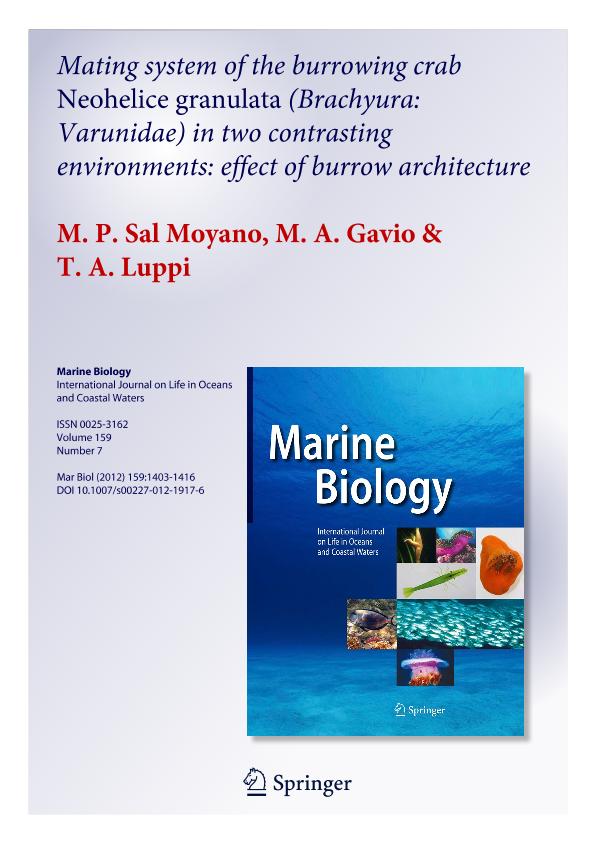Mostrar el registro sencillo del ítem
dc.contributor.author
Sal Moyano, María Paz

dc.contributor.author
Gavio, Maria Andrea

dc.contributor.author
Luppi, Tomas Atilio

dc.date.available
2021-05-10T11:42:45Z
dc.date.issued
2012-07
dc.identifier.citation
Sal Moyano, María Paz; Gavio, Maria Andrea; Luppi, Tomas Atilio; Mating system of the burrowing crab Neohelice granulata (Brachyura: Varunidae) in two contrasting environments: Effect of burrow architecture; Springer; Marine Biology; 159; 7; 7-2012; 1403-1416
dc.identifier.issn
0025-3162
dc.identifier.uri
http://hdl.handle.net/11336/131732
dc.description.abstract
Few studies conducted in crustaceans have demonstrated how habitat features could shape the mating systems. Here, the burrow of Neohelice granulata was considered as a resource used for mating, and its architecture was characterized in two contrasting study sites: Mar Chiquita Lagoon (MCL), an estuary composed of muddy sediments,and San Antonio Oeste (SAO), a marine bay composed of gravel sediment. Burrow features differed between study sites and occupant gender. Large males constructed burrows with a chamber in MCL and with a widened entrance in SAO, while small males constructed the same narrow burrows as females at both study sites. Field experiments demonstrated that burrows with chambers or widened entries are places used for copulation, although successful post-copulatory guarding was displayed only in those with chambers. The intensity of the agonistic encounters and the success of males in winning resources (burrows/females) also depend on the habitat characteristics. N. granulata shows a resource defense mating system where males employ different mating strategies according to the burrow architecture to ensure mating success.
dc.format
application/pdf
dc.language.iso
eng
dc.publisher
Springer

dc.rights
info:eu-repo/semantics/openAccess
dc.rights.uri
https://creativecommons.org/licenses/by-nc-sa/2.5/ar/
dc.subject
BURROW
dc.subject
MATING SYSTEM
dc.subject
CRUSTACEA
dc.subject
CONTRASTING HABITATS
dc.subject.classification
Biología Reproductiva

dc.subject.classification
Ciencias Biológicas

dc.subject.classification
CIENCIAS NATURALES Y EXACTAS

dc.title
Mating system of the burrowing crab Neohelice granulata (Brachyura: Varunidae) in two contrasting environments: Effect of burrow architecture
dc.type
info:eu-repo/semantics/article
dc.type
info:ar-repo/semantics/artículo
dc.type
info:eu-repo/semantics/publishedVersion
dc.date.updated
2021-04-23T19:23:01Z
dc.journal.volume
159
dc.journal.number
7
dc.journal.pagination
1403-1416
dc.journal.pais
Alemania

dc.description.fil
Fil: Sal Moyano, María Paz. Consejo Nacional de Investigaciones Científicas y Técnicas. Centro Científico Tecnológico Conicet - Mar del Plata. Instituto de Investigaciones Marinas y Costeras. Universidad Nacional de Mar del Plata. Facultad de Ciencias Exactas y Naturales. Instituto de Investigaciones Marinas y Costeras; Argentina. Universidad Nacional de Mar del Plata. Facultad de Ciencias Exactas y Naturales. Departamento de Biología; Argentina
dc.description.fil
Fil: Gavio, Maria Andrea. Consejo Nacional de Investigaciones Científicas y Técnicas. Centro Científico Tecnológico Conicet - Mar del Plata. Instituto de Investigaciones Marinas y Costeras. Universidad Nacional de Mar del Plata. Facultad de Ciencias Exactas y Naturales. Instituto de Investigaciones Marinas y Costeras; Argentina. Universidad Nacional de Mar del Plata. Facultad de Ciencias Exactas y Naturales. Departamento de Biología; Argentina
dc.description.fil
Fil: Luppi, Tomas Atilio. Consejo Nacional de Investigaciones Científicas y Técnicas. Centro Científico Tecnológico Conicet - Mar del Plata. Instituto de Investigaciones Marinas y Costeras. Universidad Nacional de Mar del Plata. Facultad de Ciencias Exactas y Naturales. Instituto de Investigaciones Marinas y Costeras; Argentina. Universidad Nacional de Mar del Plata. Facultad de Ciencias Exactas y Naturales. Departamento de Biología; Argentina
dc.journal.title
Marine Biology

dc.relation.alternativeid
info:eu-repo/semantics/altIdentifier/url/https://link.springer.com/article/10.1007/s00227-012-1917-6
dc.relation.alternativeid
info:eu-repo/semantics/altIdentifier/doi/http://dx.doi.org/10.1007/s00227-012-1917-6
Archivos asociados
